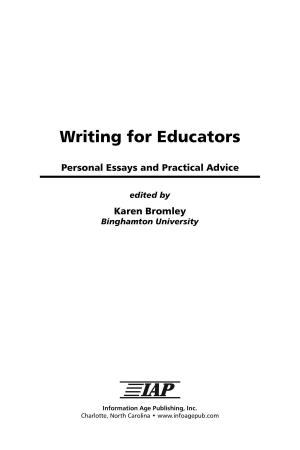The First 100 Days in the Main Office
Transforming A School Culture
Nonfiction, Reference & Language, Education & Teaching, Educational Theory, Leadership, Higher Education, Administration| Author: | Alan Jones | ISBN: | 9781641131483 |
| Publisher: | Information Age Publishing | Publication: | December 1, 2017 |
| Imprint: | Information Age Publishing | Language: | English |
| Author: | Alan Jones |
| ISBN: | 9781641131483 |
| Publisher: | Information Age Publishing |
| Publication: | December 1, 2017 |
| Imprint: | Information Age Publishing |
| Language: | English |
This book presents a series of cultural situations that could occur within the first onehundred days of a school year: responding to entrenched vocabularies and behaviors, addressing professional and instructional bad habits, enacting alternative teaching scripts, leveraging a policy blindside, redefining the goals and practices of teams, and implementing outsidethebox programs. Each cultural situation offers a new school leader the opportunity to redefine the goals, values, and practices of an entrenched school culture—the Central High way. Administrators reading the title of this book may view one hundred days as an arbitrary number picked out of administrative thin air. I argue that disrupting and replacing organizational and instructional routines is a race against time. Every school day that goes by without some sign of creative destruction is one more day that comfortable organizational and instructional routines live on in main offices and classrooms. The idea for this book originated from a question I asked a former student of mine who had just signed a contract to become the principal of a high school. We were discussing the complexities of changing a school culture when I asked the following question: “What would you do on the first day in your new office to change your school’s culture?” The response to that question described a series managerial routines that all new administrators have learned to perform as they move from the classroom to the main office: organize the office, meet staff, tour the building, write a newsletter, examine data, and visit community venues. Nothing in this conversation described strategies for redefining the beliefs and values of an entrenched school culture. With this conversation in mind, I made it a point in my formal and informal contacts with school administrators to always ask the question: “What would you do in the first day in your new office to change your school’s culture?” The most common responses involved reviewing district documents, touring facilities, meeting staff, listening to stakeholders and managing systems. In each conversation, school leaders populated their responses with the current jargon of school reform: learning communities, data mining, standardsbased curriculum, differentiated learning, common core standards, formative assessment, race to the top, continuous improvement, etc. While these responses encompass reasonable behaviors on the first day in the main office, not one of these actions possesses the capacity to connect educational values expressed in school mission statements—why are we here—to daily organizational and instructional routines. Each activity gives the appearance of leading, but produces no connections between beliefs, values, and practices. Although none of these responses would make or break a school culture, they do represent a pattern of thinking and behaving that holds out little possibility of fundamentally changing a school’s culture.
This book presents a series of cultural situations that could occur within the first onehundred days of a school year: responding to entrenched vocabularies and behaviors, addressing professional and instructional bad habits, enacting alternative teaching scripts, leveraging a policy blindside, redefining the goals and practices of teams, and implementing outsidethebox programs. Each cultural situation offers a new school leader the opportunity to redefine the goals, values, and practices of an entrenched school culture—the Central High way. Administrators reading the title of this book may view one hundred days as an arbitrary number picked out of administrative thin air. I argue that disrupting and replacing organizational and instructional routines is a race against time. Every school day that goes by without some sign of creative destruction is one more day that comfortable organizational and instructional routines live on in main offices and classrooms. The idea for this book originated from a question I asked a former student of mine who had just signed a contract to become the principal of a high school. We were discussing the complexities of changing a school culture when I asked the following question: “What would you do on the first day in your new office to change your school’s culture?” The response to that question described a series managerial routines that all new administrators have learned to perform as they move from the classroom to the main office: organize the office, meet staff, tour the building, write a newsletter, examine data, and visit community venues. Nothing in this conversation described strategies for redefining the beliefs and values of an entrenched school culture. With this conversation in mind, I made it a point in my formal and informal contacts with school administrators to always ask the question: “What would you do in the first day in your new office to change your school’s culture?” The most common responses involved reviewing district documents, touring facilities, meeting staff, listening to stakeholders and managing systems. In each conversation, school leaders populated their responses with the current jargon of school reform: learning communities, data mining, standardsbased curriculum, differentiated learning, common core standards, formative assessment, race to the top, continuous improvement, etc. While these responses encompass reasonable behaviors on the first day in the main office, not one of these actions possesses the capacity to connect educational values expressed in school mission statements—why are we here—to daily organizational and instructional routines. Each activity gives the appearance of leading, but produces no connections between beliefs, values, and practices. Although none of these responses would make or break a school culture, they do represent a pattern of thinking and behaving that holds out little possibility of fundamentally changing a school’s culture.















